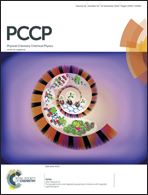Hydrogen bonding, halogen bonding and lithium bonding: an atoms in molecules and natural bond orbital perspective towards conservation of total bond order, inter- and intra-molecular bonding†
Abstract
One hundred complexes have been investigated exhibiting D–X⋯A interactions, where X = H, Cl or Li and DX is the ‘X bond’ donor and A is the acceptor. The optimized structures of all these complexes have been used to propose a generalized ‘Legon–Millen rule’ for the angular geometry in all these interactions. A detailed Atoms in Molecules (AIM) theoretical analysis confirms an important conclusion, known in the literature: there is a strong correlation between the electron density at the X⋯A bond critical point (BCP) and the interaction energy for all these interactions. In addition, we show that extrapolation of the fitted line leads to the ionic bond for Li-bonding (electrostatic) while for hydrogen and chlorine bonding, it leads to the covalent bond. Further, we observe a strong correlation between the change in electron density at the D–X BCP and that at the X⋯A BCP, suggesting conservation of the bond order. The correlation found between penetration and electron density at BCP can be very useful for crystal structure analysis, which relies on arbitrary van der Waals radii for estimating penetration. Various criteria proposed for shared- and closed-shell interactions based on electron density topology have been tested for H/Cl/Li bonded complexes. Finally, using the natural bond orbital (NBO) analysis it is shown that the D–X bond weakens upon X bond formation, whether it is ionic (DLi) or covalent (DH/DCl) and the respective indices such as ionicity or covalent bond order decrease. Clearly, one can think of conservation of bond order that includes ionic and covalent contributions to both D–X and X⋯A bonds, for not only X = H/Cl/Li investigated here but also any atom involved in intermolecular bonding.


 Please wait while we load your content...
Please wait while we load your content...